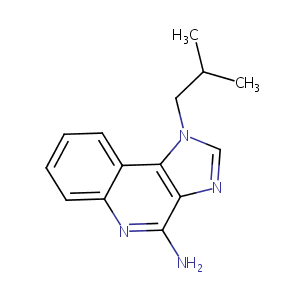| 1 |
ClinicalTrials.gov (NCT02281682) IM Versus 5-FU Versus IMI Versus MAL-PDT in Treatment of Actinic Keratosis
|
| 2 |
Imiquimod FDA Label
|
| 3 |
URL: http://www.guidetopharmacology.org Nucleic Acids Res. 2015 Oct 12. pii: gkv1037. The IUPHAR/BPS Guide to PHARMACOLOGY in 2016: towards curated quantitative interactions between 1300 protein targets and 6000 ligands. (Ligand id: 5003).
|
| 4 |
URL: http://www.guidetopharmacology.org Nucleic Acids Res. 2015 Oct 12. pii: gkv1037. The IUPHAR/BPS Guide to PHARMACOLOGY in 2016: towards curated quantitative interactions between 1300 protein targets and 6000 ligands. (Ligand id: 7443).
|
| 5 |
ClinicalTrials.gov (NCT01546571) Study of a Melanoma Vaccine in Stage IIb, IIc, and III Melanoma Patients. U.S. National Institutes of Health.
|
| 6 |
Imiquimod enhances IFN-gamma production and effector function of T cells infiltrating human squamous cell carcinomas of the skin. J Invest Dermatol. 2009 Nov;129(11):2676-85.
|
| 7 |
Summary of information on human CYP enzymes: human P450 metabolism data. Drug Metab Rev. 2002 Feb-May;34(1-2):83-448.
|
| 8 |
The Toll-like receptor agonist imiquimod is metabolized by aryl hydrocarbon receptor-regulated cytochrome P450 enzymes in human keratinocytes and mouse liver. Arch Toxicol. 2019 Jul;93(7):1917-1926.
|
| 9 |
Cannabidiol selectively modulates interleukin (IL)-1 and IL-6 production in toll-like receptor activated human peripheral blood monocytes. Toxicology. 2021 Dec;464:153016. doi: 10.1016/j.tox.2021.153016. Epub 2021 Nov 2.
|
| 10 |
(9)-Tetrahydrocannabinol Suppresses Monocyte-Mediated Astrocyte Production of Monocyte Chemoattractant Protein 1 and Interleukin-6 in a Toll-Like Receptor 7-Stimulated Human Coculture. J Pharmacol Exp Ther. 2019 Oct;371(1):191-201. doi: 10.1124/jpet.119.260661. Epub 2019 Aug 5.
|
| 11 |
Imiquimod: a potential weapon against Dupuytren contracture. Med Hypotheses. 2006;66(5):991-2. doi: 10.1016/j.mehy.2005.09.052. Epub 2005 Dec 20.
|
| 12 |
Imiquimod induces apoptosis of human melanocytes. Arch Dermatol Res. 2010 May;302(4):301-6. doi: 10.1007/s00403-009-1012-0. Epub 2009 Dec 23.
|
| 13 |
Effect of toll-like receptor 7 and 9 targeted therapy to prevent the development of hepatocellular carcinoma. Liver Int. 2015 Mar;35(3):1063-76. doi: 10.1111/liv.12626. Epub 2014 Jul 30.
|
| 14 |
Tumor-selective induction of apoptosis and the small-molecule immune response modifier imiquimod. J Natl Cancer Inst. 2003 Aug 6;95(15):1138-49. doi: 10.1093/jnci/djg016.
|
| 15 |
The skin cancer chemotherapeutic agent ingenol-3-angelate (PEP005) is a substrate for the epidermal multidrug transporter (ABCB1) and targets tumor vasculature. Cancer Res. 2010 Jun 1;70(11):4509-19.
|
| 16 |
Repurposing of ingenol mebutate for treating human colorectal cancer by targeting S100 calcium-binding protein A4 (S100A4). Toxicol Appl Pharmacol. 2022 Aug 15;449:116134. doi: 10.1016/j.taap.2022.116134. Epub 2022 Jun 18.
|
|
|
|
|
|
|


